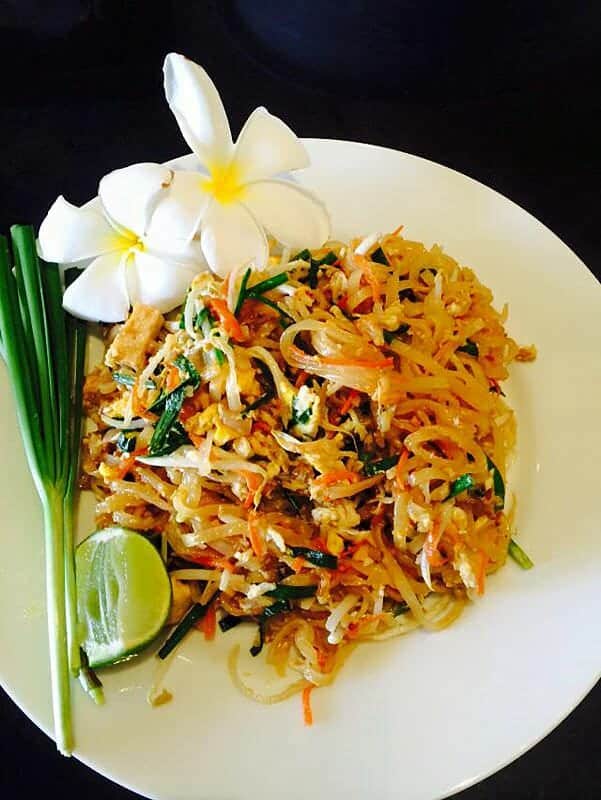Thai food is full of intense flavor and aroma. The focus on spice and fresh ingredients has made Thai food one of the leading cuisines worldwide. Even if you can’t make it to Thailand for a beach vacation, there are Thai restaurants all over the world where you can experience this excellent food for yourself.
But when you’re trying to recreate some of the tastiest Thai masterpieces at home, there can be a lot of challenges. The cooking techniques and equipment can be hard and difficult to master. But the biggest challenge is getting the right ingredients.
Kaffir lime leaves are one of those ingredients that are terribly hard to find but essential for all sorts of Thai dishes.
So if you’re asking yourself, “What can I substitute for kaffir lime leaves in my Thai dishes?” I’ve got some ideas for you…
What Are Kaffir Lime Leaves?
Shock of shocks, kaffir lime leaves are the leaves of the kaffir lime tree. Simple.
Now, What’s a Kaffir Lime Tree?
Kaffir lime or makrut in Thai is a tree that looks a lot like a lime tree. There are some differences are in the fruit and leaves. The fruit is the size, shape, and color of a large lime, but with really knobbled, gnarled skin. The fruit is intensely sour and bitter and cannot be used for its juice.
You can boil the fruit whole to get the citrus oil out of the skin for a soup base. Kaffir limes are also boiled and squeezed to make a sort of shampoo that smells divine but is pretty tough on hair.
Lime Leaf vs. Kaffri Lime Leaf
The leaves of the kaffir lime tree are also different from regular lime leaves. Their double-decker leaves look like one leaf is growing out of the tip of the previous leaf, and the single leaves have a sort of hourglass waist.
The leaves are also a lot tougher than regular lime leaves. Although the younger and more tender leaves are preferred in cooking. They have a sort of bitter, pungent flavor with an incredibly deep citrusy aroma.
How Are Kaffir Lime Leaves Used in Thai Dishes?
Thai food uses kaffir limes in three main ways depending on the type of food that’s being prepared.
Whole kaffir lime leaves are thrown into soups like the famous Tom Yam Goong (spicy and sour prawn soup) to finish them off. The aroma can degrade quickly in the heat, so the leaves are left to the end, so the dish stays nice and aromatic when served.
However, whole leaves are also boiled whole into many different curries to imbue them with citrus notes. Normally, the leaves are left in the dishes when they’re served but are pulled out and put aside by diners.
The central veins of kaffir lime leaves can be quite tough, so they’re often sliced out, leaving the two sides of the leaves long and flat. These are sliced into thin ribbons and are added to stir-fried dishes, again near the final stages of cooking to preserve the aroma. Because the tough veins are gone, and the leaves are cut super-thin, they can be eaten as is.
Curry Paste
Kaffir lime leaves are added to many different Thai curry pastes, including those for red, green, yellow, and Penang curry. Along with other ingredients like lemongrass, chili, and shallots, kaffir lime leaves are ground or pulverized into a mushy paste. They impart a great citrus smell, but their bitterness is lost in the overall curry.
Kaffir lime leaves are also deep-fried with chilies and added to peanuts, steamed, and used just for decoration. In Thailand and most of Southeast Asia, they’re cheap and easy to find – they just grow on trees.
Sourcing Kaffir Lime Leaves for Thai Dishes
Unfortunately, if you live somewhere that’s not tropical enough to support kaffir lime trees, you may have a lot more trouble trying to get your hands on the leaves. Fresh Kaffir lime leaves, for example, Fresh ORGANIC Kaffir Lime Leaves, can be found online and in some Thai and other Asian groceries.
If You Can’t Find Them Fresh
But, it’s more likely that you’re going to have to buy them either frozen or dried. Frozen leaves are definitely preferred because they still retain some of the incredible aromas that they’re prized for. I like Burmaspice Dried Kaffir Lime Leaves because they have little citrus oil left in them and can be used in a pinch.
Some companies grind the dried leaves into powder such as SIAM Herbs Kaffir Lime Leave Powder and vacuum seal them, which can help to keep in the smells. Keep in mind that the powder will give a more concentrated flavor than whole leaves, so use a lot less than you think you need.
What Can I Substitute For Kaffir Lime Leaves in My Thai Dishes?
Kaffir lime leaf brings a unique, strong citrus aroma to Thai dishes. However, it can be replaced if you really can’t get your hands on any. Here are my 4 top suggestions for kaffir lime leaf replacements…
More Lemongrass
While there’s very little doubt that your Thai food recipe also calls for lemongrass. You can add more if you have it on hand and can’t find kaffir lime leaves. It has a similar citrus smell and can be used in the same ways.
The tender inner stalk is usually minced and used in stir-frys and curry pastes. But the tougher outer leaves aren’t to be wasted. They can be cut into two to three inch lengths and boiled into curries and soups to add more great flavor.
Lemon or Lime Zest
A nice mix of lemon and lime zest does a good job and gets that fantastic citrus oil into your dishes. Use about one teaspoon to replace one kaffir lime leaf. Just be sure to add it towards the end of cooked dishes so that the aroma stays around.
Zest and Juice
You can use a combination of lime or lemon zest and juice. For example, use a ½ teaspoon of zest and a tiny squeeze of juice to replace one leaf.
Other Citrus Leaves
Lemon and lime leaves can be more tender. Although, they don’t have the same intense citrus smell as kaffir lime leaves do. And if you can get your hands on them, bergamot orange leaves are a very close alternative to kaffir lime leaves.
Interesting Fact: The word ‘kaffir’ seems to come from the Arabic word. It means someone who goes against the teachings of Islam. Somehow, now it is a derogatory word for black people in South Africa. So, why not call them ‘Thai lime’ or ‘makrut lime’ instead.
Looking For More From The East?
Look no further; our love for Japanese, Chinese, and Thai food has you covered. We’ve got a little bit of everything!
Let’s stick with Thailand first and start with the Best Thai Cookbooks, as well as the Substitutes For Fresh Ginger, the Best Seaweed Snacks, and the Best Coconut Water Brands on the market in 2021.
Next for something from Japan, check out our reviews of the Best Ramen Cookbooks, the Best Instant Ramen, the Best Ramen Bowls, the Best Classic Sushi Rolls, the Best Teriyaki Sauce, the Best Japanese Knives, the Best Japanese Rice Cookers also available today.
Or if you wanna try making your own Japanese dishes at home, then check out our in-depth reviews of the Best Sushi Making Kits as well as the Best Yakitori Grills you can buy.
Final Thoughts
Well, now you know exactly what to substitute for kaffir lime leaves in any Thai dishes. Other citrus-smelling ingredients can do a good job. However, you will be able to track down kaffir leaves fresh, frozen, dried, and even powdered if you use your kitchen sleuthing skills. And trust me, it’s well worth the effort.
Either you can find them or have to replace them with something similar. But, kaffir lime leaves are one of the quintessential Thai ingredients that give this exotic cuisine its trademark flavor.
Now, Let’s Get Leafy!
This content was originally published here.



